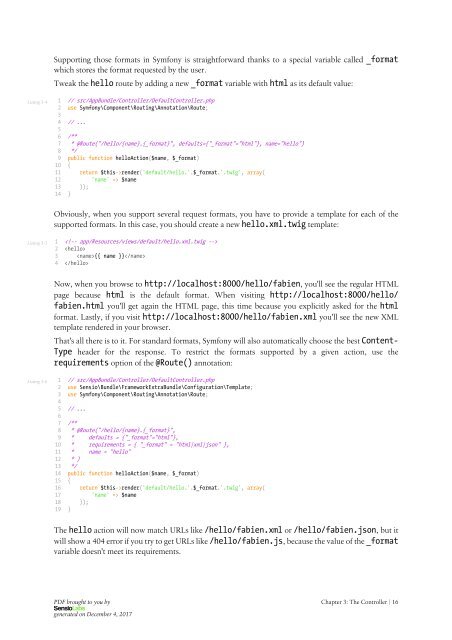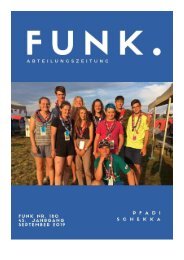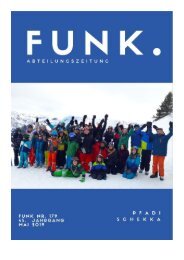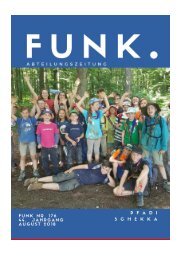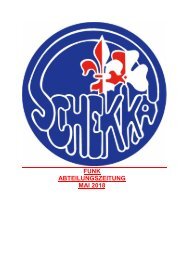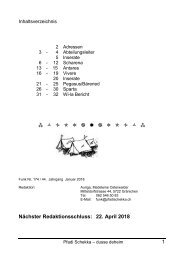Symfony_quick_tour_3.4
Create successful ePaper yourself
Turn your PDF publications into a flip-book with our unique Google optimized e-Paper software.
Supporting those formats in <strong>Symfony</strong> is straightforward thanks to a special variable called _format<br />
which stores the format requested by the user.<br />
Tweak the hello route by adding a new _format variable with html as its default value:<br />
Listing 3-4<br />
1<br />
2<br />
3<br />
4<br />
5<br />
6<br />
7<br />
8<br />
9<br />
10<br />
11<br />
12<br />
13<br />
14<br />
// src/AppBundle/Controller/DefaultController.php<br />
use <strong>Symfony</strong>\Component\Routing\Annotation\Route;<br />
// ...<br />
/**<br />
* @Route("/hello/{name}.{_format}", defaults={"_format"="html"}, name="hello")<br />
*/<br />
public function helloAction($name, $_format)<br />
{<br />
return $this->render('default/hello.'.$_format.'.twig', array(<br />
'name' => $name<br />
));<br />
}<br />
Obviously, when you support several request formats, you have to provide a template for each of the<br />
supported formats. In this case, you should create a new hello.xml.twig template:<br />
Listing 3-5<br />
1<br />
2<br />
3<br />
4<br />
<br />
<br />
{{ name }}<br />
<br />
Now, when you browse to http://localhost:8000/hello/fabien, you'll see the regular HTML<br />
page because html is the default format. When visiting http://localhost:8000/hello/<br />
fabien.html you'll get again the HTML page, this time because you explicitly asked for the html<br />
format. Lastly, if you visit http://localhost:8000/hello/fabien.xml you'll see the new XML<br />
template rendered in your browser.<br />
That's all there is to it. For standard formats, <strong>Symfony</strong> will also automatically choose the best Content-<br />
Type header for the response. To restrict the formats supported by a given action, use the<br />
requirements option of the @Route() annotation:<br />
Listing 3-6<br />
1<br />
2<br />
3<br />
4<br />
5<br />
6<br />
7<br />
8<br />
9<br />
10<br />
11<br />
12<br />
13<br />
14<br />
15<br />
16<br />
17<br />
18<br />
19<br />
// src/AppBundle/Controller/DefaultController.php<br />
use Sensio\Bundle\FrameworkExtraBundle\Configuration\Template;<br />
use <strong>Symfony</strong>\Component\Routing\Annotation\Route;<br />
// ...<br />
/**<br />
* @Route("/hello/{name}.{_format}",<br />
* defaults = {"_format"="html"},<br />
* requirements = { "_format" = "html|xml|json" },<br />
* name = "hello"<br />
* )<br />
*/<br />
public function helloAction($name, $_format)<br />
{<br />
return $this->render('default/hello.'.$_format.'.twig', array(<br />
'name' => $name<br />
));<br />
}<br />
The hello action will now match URLs like /hello/fabien.xml or /hello/fabien.json, but it<br />
will show a 404 error if you try to get URLs like /hello/fabien.js, because the value of the _format<br />
variable doesn't meet its requirements.<br />
PDF brought to you by<br />
Chapter 3: The Controller | 16<br />
generated on December 4, 2017


